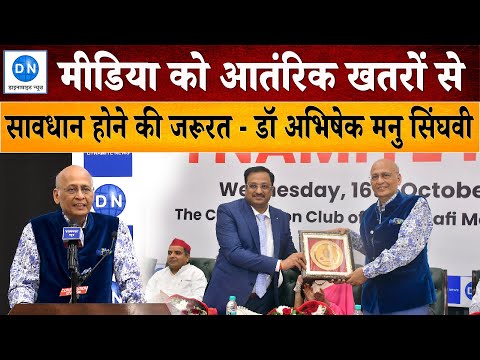Dynamite News Anniversary: Dr Abhishek Manu Singhvi reveals origin of ‘Godi’ Media
The term ‘Godi’ Media has increasingly become popular in the country for quite some time. What is the origin of ‘Godi’ Media and what does it mean? Must follow the story on Dynamite News.
New Delhi: In recent years, the popularity of the term ‘Godi’ Media has increased rapidly in the country. ‘Godi’ Media is often used as a term to condemn the 'biased' media. Opposition Parties and people of opposing ideologies usually use this term for the media that 'speaks' the 'language' of the government.
The country’s renowned jurist, legal expert, senior advocate of the Supreme Court and four-time MP Dr Abhishek Manu Singhvi explained the origin of the term ‘Godi’ Media. Dr Singhvi was speaking as the Chief Guest on the occasion of the Dynamite News 9th Anniversary celebrations hosted at the Constitution Club of India here in Delhi. Dr Singhvi also expressed his views extensively on the contemporary media scenario in the country.
Dr Abhishek Manu Singhvi said that the term 'godi' media has come into use because of Sherlock Holmes. Sherlock Holmes was the first to use this analogy. He said that when Sherlock Holmes went to investigate a case, he asked his partner about the people there whether they were 'watch dogs' but he got the answer that no, they were 'lap' dogs. 'Lap' dogs do not bark.
The word 'godi' came to Hindi from this English word 'lap' as lap in Hindi means 'godi'. As we all know that the term 'watch dog' has been used for the media for a long time.
Sherlock Holmes is a fictional character of British writer and novelist Sir Arthur Conan Doyle, whom Doyle has portrayed in his four novels and fifty-six short stories. Sherlock Holmes is also known as a brilliant detective with his intellectual skills, who investigated and solved many unsolved cases in the novels.
Also Read |
Priyanka Gandhi Vadra takes oath as MP in Lok Sabha today
Dr. Singhvi said that 'lap' dog is sometimes a matter of ambition and sometimes greed. It also reflects fear. This fear is of some things getting into the press.
He said that media is called the fourth pillar of democracy. Although it has not been given the status of the fourth pillar in the law books. But certainly its role is essentially at number four after the legislature, executive and judiciary.
He said that when we talk about the state of contemporary press, we should keep in mind that the threat to the press can be more from internal dangers than from outside. External threats include censorship, governments etc. The press should be most scared of those internal organs which are not worthy of being called the press today.
Dr Singhvi said that if the fourth pillar makes any compromise, if there is fear and ambition among the press, then a national danger will arise. Unless you (press) walk with your torch and your responsibility, you (press) do not have the right to be called the fourth pillar.
India: Press Freedom Index
Dr Singhvi said that here a figure of Press Freedom Index 2024 was presented, in which India's position is 159 out of 180. Now I want to add another worrying thing which is related to the safety of journalists and their working ecosystem. India's number in this index is 172 out of 180, which is a big alarm bell for us.
Also Read |
HC issues notice to Delhi Govt on BJP MPs PIL on Ayushman Bharat Scheme
Increase in sedition cases
He said that the figures show that in 2023-24, 103 journalists in the country were targeted by state actors, while more than 90 journalists were targeted by non-state actors. Journalists often get trapped in sedition cases too. Such a statement was also recorded in the Supreme Court in mid-2021.
Between 2014 and 2022, the number of journalists arrested in sedition cases increased tremendously and the trials also saw a speed-up.
 Dynamite News
Dynamite News 
